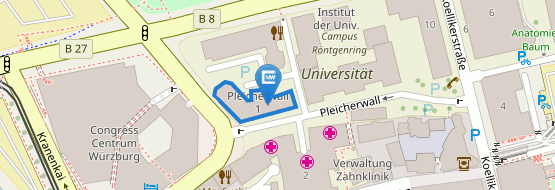New exhibition: "Carl Stumpf (1848-1936) and the beginnings of Gestaltpsychology"
06/08/2015When the Adolf-Würth-Center earned important parts of the philosopher and psychologist Carl Stumpfs (1848-1936) estate as private donation, Professor Armin Stock rapidly realized that this would lead to a new exhibition. On May 22, it was now opened with a small ceremony.
“Starting in Wuerzburg out into the world” is a popular slogan that the Wuerzburg University uses to emphasize the excellent education it provides. That the above mentioned statement was true even 150 years ago shows Carl Stumpfs impressive scientific career. Stumpf who was born in Wiesentheid near Wuerzburg in the revolution year of 1848 and whose birthplace can still be visited arrived at the age of seventeen in the City by the Main river to start his studies. He first studied law in order to pursue a career that allows him a stable income and sufficient time to follow his passion for music. But he shouldn’t be able to maintain his intent for long. His visit of the public defense of Franz Brentano’s (1838- 1917) doctor thesis became a crucial experience and lasted a lifetime. Impressed by Brentano’s clear, stringent and logical thinking Carl Stumpf became first his student and later a friend until Brentano’s death. However, Brentano was not allowed to offer a doctorate or habilitation as to why he advised Stumpf the University of Goettingen where Rudolf Hermann Lotze (1817-1881) worked. Having already achieved these academic distinctions in 1870 he returned to Wuerzburg after three years lecturing in Goettingen. Here he was appointed professor of philosophy at just 25 years of age. In Wuerzburg he started his psychological studies on sounds supported by Friedrich Kohlrauch (1840-1910) who run the Physics Department and provided Stumpf the musical instrument collection. These studies were later published in two volumes called Tonpsychologie (Psychology of sounds) and became next to Helmholtz’ Lehre von den Tonempfindungen (Teachings about the Perception of Sound) a standard reference accepted by philosophers and psychologists alike.
Carl Stumpf worked in Wuerzburg for six years before he newly wed followed a call to the University of Prague in 1879. During his time in Prague Stumpf continued his studies on the psychology of sounds under difficult conditions as he lacked in the Wuerzburg Physics Department’s instrument collection. In addition, the time was marked by the political tensions between Germans and Czechs which resulted in the University’s division in two parts: a German and a Czech one. Out of fear for his family’s safety (enlarged through their first sons birth), Stumpf looked out for and finally found a new position at the University of Halle in 1884. Thanks to the contemplative city Stumpf was able to revive his creativity and energy. He got to work on the second volume of the Tonlehre (Psychology of Sounds) and used the local cathedral’s organ for his studies. Upon the recommendation of Brentano the young philosopher Edmund Husserl (1859-1938) joined Stumpf and qualified as professor under his supervision. In Halle Carl Stumpf also started his ethnological recordings of the Bellakula Native People’s and Mongolian singings. Thereby he laid the foundation of his later established Phonogram Archive in Berlin which is nowadays ranked among the UNESCO’s Memory of the World.
Halle was known to be a steppingstone for scientific careers and it was indeed for Carl Stumpf because after only five years he accepted a call from the University of Munich. Stumpf always tried to combine philosophy, especially epistemology, with the methods of the young empirical psychology and natural sciences. Therefore, he was called an ideal cast welcomed by philosophers who complied with the University’s modernization efforts and innovative developments in psychology. In Munich Stumpf had the opportunity to build his own instrument collection for the very first time. If the ministry had allowed him, Stumpf would have been able to establish – from today’s perspective- one of the oldest psychology departments. However, the people were not that farsighted in those days and Carl Stumpf moved to Berlin instead. After first rejections of Friedrich Althoff’s (1839-1908) recruits, he finally accepted the call from the Friedrich- Wilhelms- University. Here, he built up a department of world renown up until 1920. He produced well-known personalities such as Wolfgang Köhler (1887-1967), Kurt Koffka (1886-1941), Kurt Lewin (1890-1947), Max Wertheimer (1880-1943) and Friedrich Schumann (1863-1940). Thanks to their development of the Gestaltpsychology, new approaches in thinking and searching became possible. Carl Stumpf died of old age and highly respected in Berlin on 25 December 1936.
Providing numerous original documents the Adolf- Würth- Center’s exhibition shows the life and work of Carl Stumpf as well as of Wolfgang Köhler, Max Wertheimer, Kurt Koffka, Kurt Lewin and Karl Duncker. In addition, visitors are allowed to experience particular experiments by Max Wertheimer on original equipment. The exhibition is available to the public from 25 Mai 2015 during opening hours of the Adolf- Würth- Center. In order to book a guided tour please contact us, Telephone: 0049931/ 3188683 or zgp@uni-wuerzburg.de .


